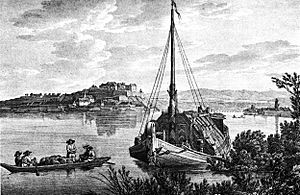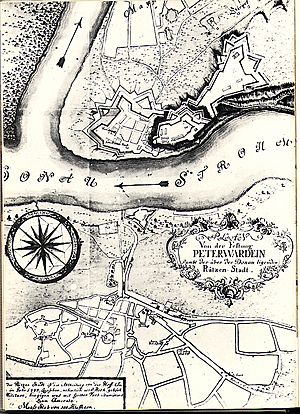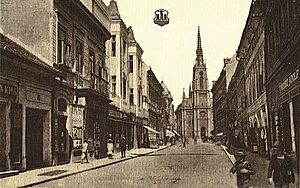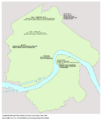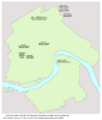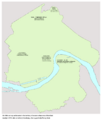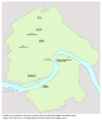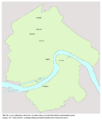History of Novi Sad facts for kids
Novi Sad is the second largest city in Serbia. Its story began long ago, in the Stone Age, in a place called Petrovaradin. Later, the Celts built the first fort there. The Romans then built a bigger fort in the 1st century AD. But the Huns destroyed it in the 5th century. The Byzantines rebuilt it.
Over time, many different groups ruled the city. It was eventually taken over by the Kingdom of Hungary. The name Petrovaradin was first written down in 1237. In the 16th century, the Ottoman Empire took control, and in the 17th century, the Habsburg monarchy ruled.
During Habsburg rule, people who followed the Orthodox Christian faith were not allowed to live in Petrovaradin. So, in 1698, a new town was started on the other side of the Danube river. It was first called Ratzen Stadt, which meant "the Serb City." In 1748, this new town officially became "Novi Sad" (or Neoplanta in Latin) and was named a "free royal city."
By 1780, Novi Sad had about 2,000 houses. More than half of these, 1,144, belonged to Serbs. For much of the 18th and 19th centuries, Novi Sad was the biggest city in the world where most people were ethnic Serbs. After 1867, Novi Sad became part of the Hungarian side of Austria-Hungary. During this time, the Hungarian government tried to make everyone speak Hungarian. This changed who lived in the city, and more people started speaking Hungarian.
In 1941, during World War II, Hungary took over Novi Sad. About 5,000 people were killed, and many others had to leave their homes. Since 1945, Novi Sad has been the capital of Vojvodina. This is a province in what was then Socialist Federal Republic of Yugoslavia. After 1992, Novi Sad was part of the Federal Republic of Yugoslavia. This country later became Serbia and Montenegro in 2003.
In 1999, during the Kosovo War, NATO bombed Novi Sad. All three of its bridges over the Danube were destroyed. The city also lost its communication, water, and electricity. The oil refinery was bombed every day, which caused a lot of environmental damage. Today, Novi Sad is a part of independent Serbia.
Contents
The Ancient History of Petrovaradin
People have lived in the area of Novi Sad for a very long time. The earliest signs of human settlement go back to the Stone Age, around 4500 BC. These early people lived on the right bank of the Danube river, where Petrovaradin is today.
Around the 4th century BC, the Celts arrived and took over this region. They built the first fort on the right bank of the Danube. Then, in the 1st century BC, the Romans conquered the area. They built a larger fort called Cusum in the 1st century AD. This fort was part of the Roman province of Pannonia. In the 5th century, the Huns attacked and destroyed Cusum.
By the end of the 5th century, the Byzantines rebuilt the city. They called it Cusum and Petrikon. Over time, different groups ruled the city. These included the Ostrogoths, Gepids, Avars, Franks, and Bulgarians. The Byzantines also ruled it again.
Later, the Kingdom of Hungary took control in the 11th–12th centuries. The Ottoman Empire conquered it in 1526. Finally, the Habsburg monarchy took over in 1687. The name Peturwarad (or Petrovaradin) was first mentioned in official papers in 1237. Other names used for it were Bélakút, Pétervárad (under Hungarian rule), Varadin (under Ottoman rule), and Peterwardein (under Habsburg rule).
During the time of Ottoman rule, Petrovaradin had about 200 houses and three mosques. There was also a Christian area with 35 houses, where ethnic Serbs lived.
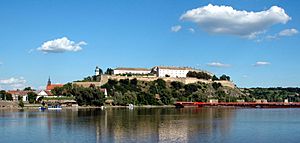
Older Settlements in the Area
Before Novi Sad (Ratzen Stadt) was founded in 1694, there were other settlements on the left bank of the Danube. These were in the area where Novi Sad is now. In 1237, several settlements were mentioned. Between the 13th and 16th centuries, these towns existed:
- Baksa or Baksafalva (Serbian: Bakša or Bakšić) – This was near the modern Stari Grad neighborhood.
- Kűszentmárton (Serbian: Sent Marton) – This was near the modern Telep neighborhood.
- Bivalyos or Bivalo (Serbian: Bivaljoš or Bivalo) – This was near the modern Slana Bara neighborhood.
- Vásárosvárad (Serbian: Vašaroš Varad or Varadinci) – This was near the modern Klisa neighborhood.
- Zajol I (Serbian: Sajlovo I or Gornje Sajlovo) – This was near the modern Klisa and Gornje Livade neighborhoods.
- Zajol II (Serbian: Sajlovo II or Donje Sajlovo) – This was near the modern Sajlovo neighborhood.
- Bistritz (Serbian: Bistrica) – This might have been near the modern Bistrica neighborhood.
Some of these names come from Slavic languages, showing that Slavs lived there first. For example, Bivalo (Bivaljoš) was a large Slavic settlement from the 5th–6th century. Other names are from Hungarian, meaning Hungarians lived there before the Ottoman invasion.
Tax records from 1522 show a mix of Hungarian and Slavic names among the people living in these villages. After the Ottoman invasion in the 16th–17th centuries, some villages were destroyed. Most Hungarian people left the area. Some villages continued to exist under Ottoman rule and were home to ethnic Serbs.
In 1590, all the villages in the area of present-day Novi Sad had 105 houses. Only Serbs lived in them. However, Ottoman records only counted people who paid taxes. So, the actual number of Serbs living there was probably higher.
How Novi Sad Began
When the Habsburgs took over, Orthodox Christians were not allowed to live in Petrovaradin. Because of this, a new settlement was started in 1694 on the left bank of the Danube. It was first called Ratzen Stadt (Serbian: Racki Grad), which means "the Serb City." It was also known as Peterwardein Schantz (Serbian: Petrovaradinski Šanac). In 1718, people from the village of Almaš moved to Petrovaradinski Šanac. They created a new part of town called Almaški Kraj.
In 1720, Ratzen Stadt had 112 Serbian, 14 German, and 5 Hungarian houses. The settlement officially got its current name, Novi Sad (Neoplanta in Latin), in 1748. This happened when it became a "free royal city." By 1780, Novi Sad had about 2,000 houses, and 1,144 of them were Serbian.
The special order that made Novi Sad a "free royal city" was given on February 1, 1748. Maria Theresa, the Queen, declared that Petrovaradinski Šanac would become a "Free Royal City." Its old name was removed, and it was renamed Neoplanta (Latin), Újvidék (Hungarian), Neu-Satz (German), and Novi Sad (Serbian).
Novi Sad's Growth (1748-1918)
For much of the 18th and 19th centuries, Novi Sad was the largest city in the world where most people were ethnic Serbs. It was a very important cultural and political center for Serbs. At that time, Serbs did not have their own country. Because of its importance, Novi Sad became known as the Serb Athens.
In 1843, Novi Sad had 17,332 people. Most were Orthodox Christians, followed by Catholics, Protestants, and Jews. The largest ethnic group was Serbs, and the second largest was Germans.
During the Revolution of 1848–1849, Novi Sad was part of Serbian Vojvodina. This was a Serbian area within the Habsburg Empire. In 1849, the Hungarian army on the Petrovaradin Fortress bombed and destroyed much of the city. Many people left. By 1850, only 7,182 people lived there, compared to about 20,000 in 1820.
Between 1849 and 1860, the city was part of a special Austrian area called the Voivodeship of Serbia and Temes Banat. After this area was removed, the city became part of Bacsensis-Bodrogiensis County. After 1867, Novi Sad was in the Hungarian part of Austria-Hungary. During this time, the Hungarian government tried to make people speak Hungarian more. This changed the mix of people in the city. It went from being mostly Serbian to having a mix of different groups.
In 1880, 41.2% of people spoke Serbian, and 25.9% spoke Hungarian. By 1910, the number of Serbian speakers went down to 34.52%, while Hungarian speakers increased to 39.72%. The 1910 census might not be fully accurate. It asked about the "most frequently spoken language," not ethnic background. Many non-Hungarians might have said they spoke Hungarian because it was the official language.
After the First World War
On November 3, 1918, after World War I, Serbian groups were formed in Novi Sad. On November 9, 1918, Serbian troops entered the city. On November 25, 1918, a big meeting of Serbs, Bunjevci, and other groups in Vojvodina decided to join the Kingdom of Serbia. On December 1, 1918, Novi Sad became part of the new Kingdom of Serbs, Croats, and Slovenes.
By 1921, Novi Sad had 39,122 people. Most were Serbs (16,071), followed by Hungarians (13,065), and Germans (6,486). In 1929, Novi Sad became the capital of the Danube Banovina, a province in the Kingdom of Yugoslavia.
In 1941, during World War II, Hungary took over Novi Sad. About 5,000 people were killed, and many others were forced to move. In 1942, Hungarian police killed 1,246 people in one raid. They threw their bodies into the Danube. People from all groups, including Serbs, Hungarians, and Slovaks, worked together to resist the Axis rulers. On August 7, 1944, the Allies bombed Novi Sad's oil factories.
Serbian forces entered the city on October 23, 1944. Novi Sad then became part of the new socialist Yugoslavia. After the war, those who committed war crimes were punished.
Since 1945, Novi Sad has been the capital of Vojvodina. It is a province within Socialist Republic of Serbia and Socialist Federal Republic of Yugoslavia. The city grew very fast. Its population more than doubled between World War II and the breakup of Yugoslavia.
After 1992, Novi Sad was part of the Federal Republic of Yugoslavia. This country later changed to Serbia and Montenegro in 2003. Since 2006, Novi Sad has been part of independent Serbia.
In 1999, during the Kosovo War, NATO bombed Novi Sad. All three of its bridges over the Danube were destroyed. The city lost its communication, water, and electricity. Homes were bombed several times. The oil refinery was bombed daily, causing serious pollution and environmental damage.
Images for kids
See also
- NATO bombing of Novi Sad in 1999
- Demographic history of Novi Sad


